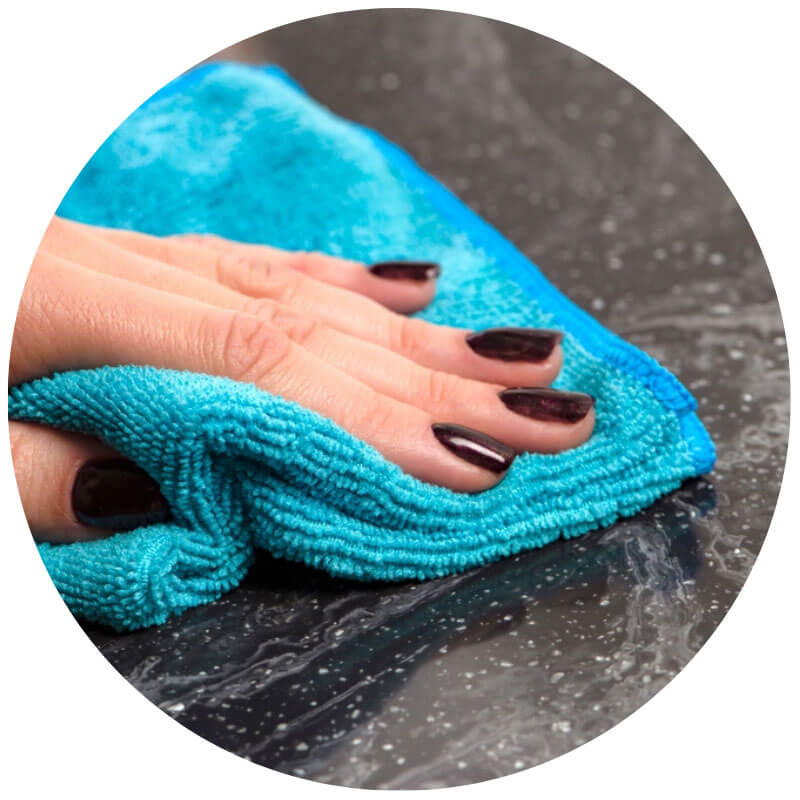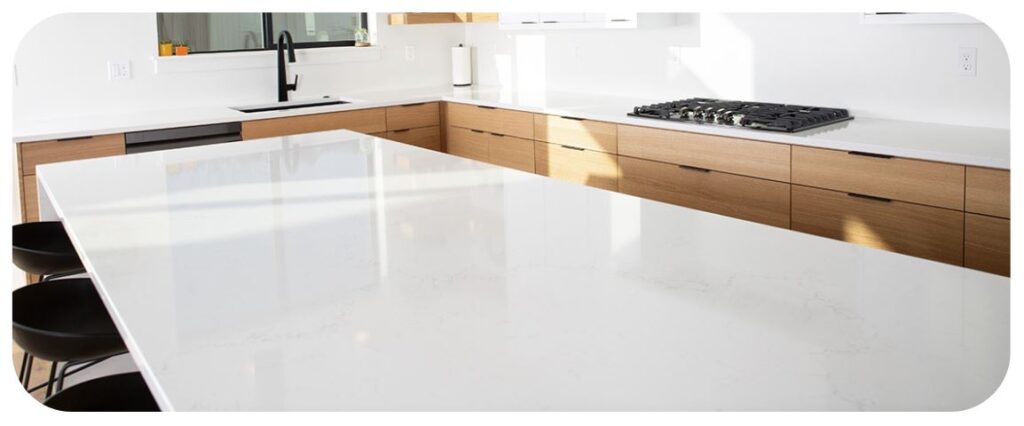Care
For Your New Countertops
You finally have your dream space installed. Now take
good care of it so it will last for years.
Care
For Your New Countertops
You finally have your dream space installed. Now take good care of it so it will last for years.
Countertop Care Guide
Regular Cleaning
Due to our stone’s high density and non-porous qualities, normal cleaning with a damp cloth and mild detergent is all you need to keep your stone surface looking great. Thoroughly rinse off the soap/mild detergent with hot water after use and dry with soft cloth or paper towel. To avoid dulling the surface shine, make sure to use a non-abrasive cleaner, and thoroughly rinse off with water after use. Those wishing to use environmentally safe cleaners may also use a combination of 50/50 vinegar and water, rinsing afterwards.
Stubborn Food Stains
If needed, apply a generous amount of a non-abrasive gel, such as Soft Scrub Liquid Gel with Bleach, to a damp soft cloth or paper towel (not directly on to the countertop). Wipe the area using a circular motion, rinsing thoroughly with water and dry with soft cloth or paper towel. We recommend a thorough cleaning of your stone’s surface on a regular basis (because of the patina that will develop on the surface from day-to day use) to keep the surface as beautiful as the day it was installed.
Metal Marks/Rust Special Use for Spot Cleaning ONLY
Because of the abrasive nature of this cleaner, use Liquid Barkeeper’s Friend only as follows: Place small amount on damp cloth. Using very light pressure, wipe the area where the marks are in a circular motion, rinsing thoroughly with warm water and dry with soft cloth or paper towel.
Dried Spills
To remove adhered material such as food, gum or nail polish, first carefully scrape away the excess material with a plastic putty knife and then clean the surface with a damp cloth to remove any marks left behind and any residual dirt. Also, do not use any abrasive pads to clean tougher dirt as abrasives can damage the finish/sheen of your countertops.

Please note that HONED, CONCRETE, MOTIVO and TEXTURED finishes require more cleaning than our polished finishes. Since there is more exposed surface area with these finishes, metal marks, finger prints, and other signs of daily living will show on honed material. Most of these marks can be easily removed with little effort and non-abrasive cleaning products such as Soft Scrub Liquid Gel.

Are there any chemicals or cleaners to avoid using? Prolonged exposure to cleaning solutions may cause permanent damage/discoloration to the countertop surface. Avoid exposing your stone to chemicals, such as oven grill cleaners, floor strippers, paint removers/strippers, toilet bowl cleaners, oil soaps, tarnish removers, furniture cleaners, drain products, battery acid, dishwasher detergent, etc. Should your surface accidentally be exposed to any potentially damaging products, rinse immediately with water to neutralize the effect.
How will your stone withstand heat? Any stone material can potentially be damaged by sudden and rapid temperature changes, especially near the edges. Therefore, using inexpensive and readily available trivets is always recommended, especially when using cooking units such as electric frying pans, crock pots, or toaster ovens. Do not put hot cookware directly on your stone surface.
How durable are our stones? Tough, yes – Indestructible, No. Our stones are resistant to cracks, scratches and stains. However, like most materials, excessive force and/or pressure from objects can damage the surface. As with any surface, stone surfaces can be permanently damaged by exposure to strong chemicals and solvents. Use of a minimum 1/8” pencil round radius on an edge detail profile can reduce the susceptibility for chipping on the edge. A greater radius is recommended for high traffic areas.
Stone surfaces are scratch resistant; however, avoid using sharp objects such as sharp knives or screwdrivers directly on the surface. The use of a cutting board is always recommended.

